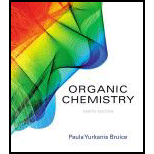
Pearson eText Organic Chemistry -- Instant Access (Pearson+)
8th Edition
ISBN: 9780135213711
Author: Paula Bruice
Publisher: PEARSON+
expand_more
expand_more
format_list_bulleted
Question
Chapter 27, Problem 31P
Interpretation Introduction
Interpretation:
A transesterification reaction mechanism that produces dimethyl terephthalate and 1,2-ethanediol from poly(ethylene terephthalate) and methanol has to be shown.
Expert Solution & Answer
Trending nowThis is a popular solution!

Students have asked these similar questions
Draw the structure of the polymer that results from anionic polymerization of p-trichloromethylstyrene (CCl3C6H4CH =CH2) using ethylene oxide as the electrophile to terminate the chain.
Provide the mechanism for the step-growth polymerization of citric acid and ethylene glycol to form poly (ethylene glycol)-citrate. Show all steps.
Poly(ethylene terephthalate) is a linear polyester that can be synthesized from the condensation polymerization between terephthalic acid and ethylene glycol, as shown previously in Equation 26-27. What alcohol would you react with terephthalic acid to produce a branched polyester? Draw a portion of the resulting polymer that shows a main chain and one branching point.
Chapter 27 Solutions
Pearson eText Organic Chemistry -- Instant Access (Pearson+)
Ch. 27.3 - Prob. 1PCh. 27.3 - Prob. 2PCh. 27.3 - Prob. 3PCh. 27.3 - Prob. 4PCh. 27.3 - Prob. 5PCh. 27.3 - Prob. 6PCh. 27.4 - Prob. 7PCh. 27.5 - Rank the following groups of monomers from most...Ch. 27.5 - Why does methyl methacrylate not undergo cationic...Ch. 27.6 - Prob. 10P
Ch. 27.6 - Explain why, when propylene oxide undergoes...Ch. 27.6 - Which monomer and which type of initiator can you...Ch. 27.6 - Prob. 13PCh. 27.8 - Draw a short segment of gutta-percha.Ch. 27.8 - Prob. 15PCh. 27.11 - Prob. 16PCh. 27.11 - Write an equation that explains what happens if a...Ch. 27.11 - What happens to polyester slacks if aqueous NaOH...Ch. 27.11 - a. Propose a mechanism for the formation of the...Ch. 27.11 - Explain why, when a small amount of glycerol is...Ch. 27.12 - Propose a mechanism for the formation of melmac.Ch. 27.12 - Prob. 22PCh. 27.13 - Prob. 23PCh. 27 - Draw short segments of the polymers obtained from...Ch. 27 - Prob. 25PCh. 27 - Prob. 26PCh. 27 - Draw the structure of the monomer or monomers used...Ch. 27 - Prob. 28PCh. 27 - Draw short segments of the polymers obtained from...Ch. 27 - Quiana is a synthetic fabric that feels very much...Ch. 27 - Prob. 31PCh. 27 - Prob. 32PCh. 27 - Prob. 33PCh. 27 - Poly(vinyl alcohol) is a polymer used to make...Ch. 27 - Five different repeating units are found in the...Ch. 27 - Prob. 37PCh. 27 - A particularly strong and rigid polyester used for...Ch. 27 - Prob. 39PCh. 27 - Which Monomer gives a greater yield of polymer,...Ch. 27 - Prob. 41PCh. 27 - Prob. 42PCh. 27 - Why do vinyl raincoats become brittle as they get...Ch. 27 - The polymer shown below is synthesized by...Ch. 27 - Prob. 45PCh. 27 - How can head-to-head poly(vinyl bromide) be...Ch. 27 - Delrin (polyoxymethylene) is a tough...
Knowledge Booster
Similar questions
- Draw the repeat unit of the polymer produced by cationic polymerization of 1,3-dioxolane using HBF4, a strong acid, as catalyst. 1,3-dioxolanearrow_forwardPoly(vinyl alcohol), a hydrophilic polymer used in aqueous adhesives, is made by polymerizing vinyl acetate and then hydrolyzing the ester linkages. We have seen that basic hydrolysis destroys the Dacron polymer. Poly(vinyl acetate) is converted to poly(vinyl alcohol) by a basic hydrolysis of the ester groups. Why doesn’t the hydrolysis destroy the poly(vinyl alcohol)polymer?arrow_forwardKodel is a condensation polymer made from terephthalic acid and 1,4-cyclohexanedimethanol. Write the structure of the resulting polymer.arrow_forward
- Write equations for the following reactions: Aldehyde + NaOH (Cannizarro’s reaction) Aldehyde + Sodium Hydrogen Sulfite Preparation of aldehyde from primary alcohol Linear polymerization of formaldehyde Cyclic polymerization of formaldehyde Linear polymerization of acetaldehyde Cyclic polymerization of acetaldehydearrow_forwardDraw the structure of the following polymers and indicate the polymerization type responsible for the givenpolymers.Indicate, where appropriate, the polyester, polyamide or polyurethane linkages.a) Poly(ethene terephthalate)b) Poly(vinyl alcohol)c) Polyisoprene and isomer structures of polyisoprened) Poly(methyl methacrylate)e) Polycaprolactamarrow_forwardDraw the structure of the monomer or monomers used to synthesize the following polymers, and indicate a chain-growth polymer or a step-growth polymer.arrow_forward
- Draw the structure of the polymer formed from ring-opening metathesis polymerization (ROMP) of each monomer.arrow_forwardThe following polymer may be used as polymer binders for coatings; please write down the structure of the monomer(s) that should be used to synthesize the polymerarrow_forwardWrite equations for the following reactions: Aldehyde + acidified potassium permanganate Aldehyde + Tollens reagent Aldehyde + Fehling’s reagent Aldehyde + NaOH (Cannizarro’s reaction) Aldehyde + Sodium Hydrogen Sulfite Preparation of aldehyde from primary alcohol Linear polymerization of formaldehyde Cyclic polymerization of formaldehyde Linear polymerization of acetaldehyde Cyclic polymerization of acetaldehydearrow_forward
arrow_back_ios
arrow_forward_ios
Recommended textbooks for you
 EBK A SMALL SCALE APPROACH TO ORGANIC LChemistryISBN:9781305446021Author:LampmanPublisher:CENGAGE LEARNING - CONSIGNMENT
EBK A SMALL SCALE APPROACH TO ORGANIC LChemistryISBN:9781305446021Author:LampmanPublisher:CENGAGE LEARNING - CONSIGNMENT Organic ChemistryChemistryISBN:9781305580350Author:William H. Brown, Brent L. Iverson, Eric Anslyn, Christopher S. FootePublisher:Cengage Learning
Organic ChemistryChemistryISBN:9781305580350Author:William H. Brown, Brent L. Iverson, Eric Anslyn, Christopher S. FootePublisher:Cengage Learning Chemistry: The Molecular ScienceChemistryISBN:9781285199047Author:John W. Moore, Conrad L. StanitskiPublisher:Cengage Learning
Chemistry: The Molecular ScienceChemistryISBN:9781285199047Author:John W. Moore, Conrad L. StanitskiPublisher:Cengage Learning

EBK A SMALL SCALE APPROACH TO ORGANIC L
Chemistry
ISBN:9781305446021
Author:Lampman
Publisher:CENGAGE LEARNING - CONSIGNMENT

Organic Chemistry
Chemistry
ISBN:9781305580350
Author:William H. Brown, Brent L. Iverson, Eric Anslyn, Christopher S. Foote
Publisher:Cengage Learning

Chemistry: The Molecular Science
Chemistry
ISBN:9781285199047
Author:John W. Moore, Conrad L. Stanitski
Publisher:Cengage Learning
